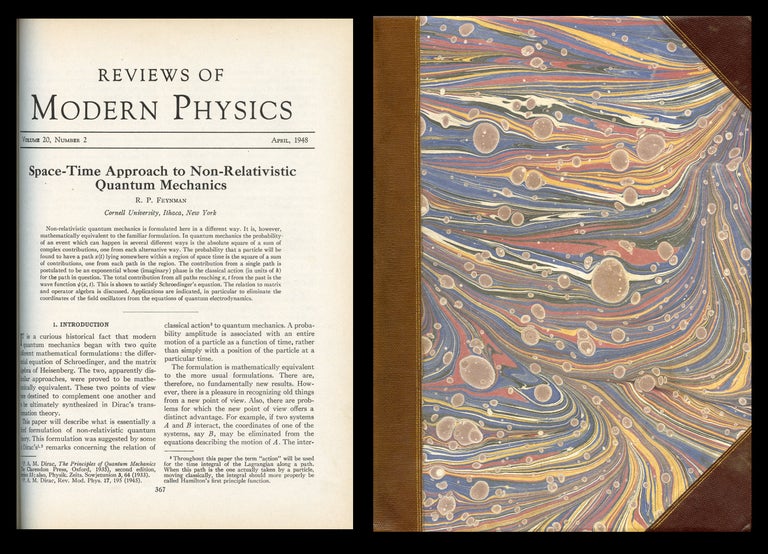Space-Time Approach to Non-Relativistic Quantum Mechanics in Reviews of Modern Physics, Vol. 20, pp. 367 to 387, 1948.
Lancaster, PA: American Physical Society, 1948. 1st Edition. FIRST EDITION, FULL VOLUME in PRISTINE CONDITION, OF FEYNMAN’S NOBEL PRIZE WINNING PATH-INTEGRAL FORMALISM, A “REFORMATION OF QUANTUM MECHANICS ITSELF” (American National Biography). Feynman’s path-integral formulation of quantum mechanics lead physicists out of the morass of endless calculations and provided them with the simplest, most elegant, most powerful – to say nothing of the most revolutionary – method for solving the fundamental equations of quantum mechanics.
Feynman’s “path-integral formulation of quantum mechanics is a description of quantum theory that generalizes the action principle of classical mechanics. It replaces the classical notion of a single, unique trajectory for a quantum particle or system” with the idea that the evolution of a quantum system is determined as a sum over – or integration of -- all the possible trajectories that would take that system from the initial to the final state of its dynamical evolution (Wenner Collection). While Feynman’s approach, as ever, was intuitive, his idea of summing over all paths has been characterized simply as “everything that can happen does happen.”
Richard Feynman “had unusual mathematical skill, but his greatest virtues as a physicist were his physical intuition and his delight in finding simple and elegant approaches to problems that had baffled everyone else” (Peacock, The Quantum Revolution, 102). There are three pivotal formulations of quantum mechanics: Heisenberg's matrix formulation, Schrödinger’s wave equation formulation, and Feynman’s path-integral formulation. Feynman began work on his path-integral formulation because, as he often said, “he could not understand standard quantum theory and had to recreate it on his own” (ibid).
Feynman introduced his path-integral method in the paper offered here, describing it as a “space-time approach to non-relativistic quantum mechanics” that was meant to provide an alternative to the “very well-established formulation of quantum mechanical time-evolution based on the Schrodinger and the Heisenberg pictures of quantum mechanics” (Prugovecki, Principles of Quantum), 88).
“Ultimately what distinguished Feynman’s approach from the standard formalism lay not in outcomes, but in… his “conceptual approach. Heisenberg and Bohr had argued vehemently during the 1920s that quantum mechanics spelled the end for any type of visualization of the atomic domain” (DSB, XXI, 21). Feynman response was the path-integral formulation, “an intuitive approach built around picturing the paths of particles through space and time” (ibid). His formulation represented a different way of thinking “that is probably as visualizable as any theory of quantum fields is ever going to be” – and in part because it could be delineated, could be diagrammed, it has spurred the study of and illuminated some of the deepest aspects of quantum mechanics” (Peacock).
Later in life and while speaking of both that with his path-integral formulation, quantum theory was simpler than classical theory, as well as of those “deepest aspects of quantum mechanics,” Feynman “who understood quantum theory as well as anyone, said, “I still get nervous with it...I cannot define the real problem, therefore I suspect there’s no real problem, but I’m not sure there’s no real problem. The problem is not with using the theory — making calculations, applying it to engineering tasks — but in understanding what it means. What does it tell us about the world?”” (Gleick, What is Real? ).
In 1965, Feynman (with Tomonaga and Schwinger) won the 1965 Nobel Prize for “fundamental work in quantum electrodynamics, with deep-ploughing consequences for the physics of elementary particles" (Nobel Foundation). Item #1640
CONDITION: Lancaster, PA, American Physical Society, 1948. 4to. Handsome complete volume. Rebound in ¾ gilt-tooled brown cloth over marbled boards. Black cloth, gilt-lettered labels. Not a library book; clean & bright with no markings whatsoever inside & out. Near fine condition.
Price: $3,000.00

